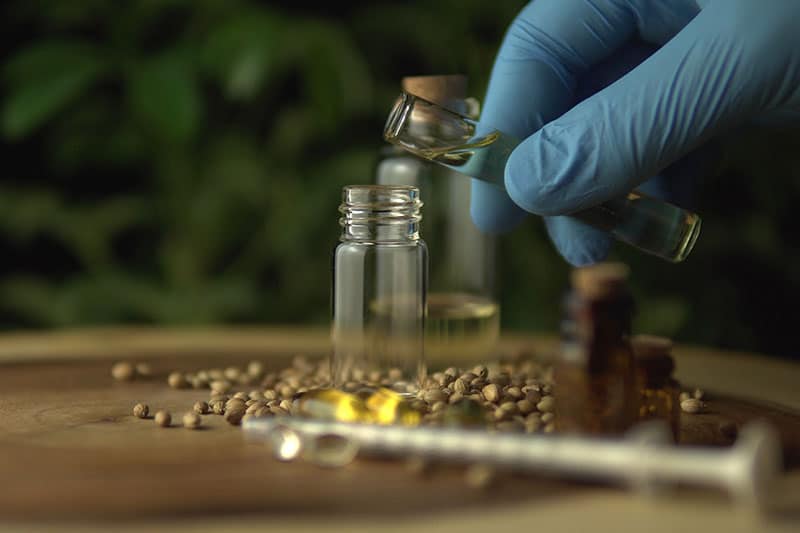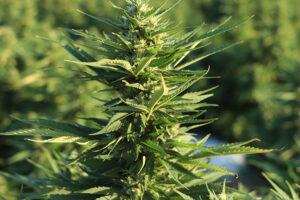Migraines affect a significant amount of the population and can cause debilitating pain and nausea. Many people find that over the counter, and even prescription medications are ineffective for managing the symptoms of migraines. CBD, one of the most common cannabinoids found in cannabis, has been extensively researched as a potent pain reliever, making it an appealing choice for migraine and headache sufferers.
But does it work?
What is CBD?
CBD, or cannabidiol, belongs to a class of compounds known as cannabinoids. These compounds are found in cannabis plants and interact with a system of receptors in our brains known as the endocannabinoid system. Another well-known cannabinoid is THC, which is responsible for the euphoric high typically associated with ingesting marijuana. Unlike THC, CBD doesn’t have psychoactive effects. Instead, it appears to reduce anxiety and decrease the sensation of pain. This has made CBD an appealing research subject for chronic pain management.
How Does CBD Work?
To understand how CBD works, you first need to understand the endocannabinoid system. The endocannabinoid system is a signaling system that responds to stress from the peripheral and central nervous systems. Endocannabinoids are compounds produced by the body which bind to special receptors found in cells. When a compound binds to a receptor, it triggers several processes that cause cells to behave in a certain way.
There are two main endocannabinoids produced in the body: CB1 and CB2. CB1 receptors are located in the brain and in the peripheral and central nervous systems. CB1 receptors are also responsible for mediating the behavioral and psychotropic effects of cannabinoids that are responsible for the high you get when ingesting THC. CB2 receptors are found mostly in peripheral tissues and in the immune system. They are responsible for mediating and controlling the inflammation response that occurs in the body due to stress.
These two receptors can work independently or synergistically in the body. The endocannabinoid system affects most organ systems in the body in some way. The main function of the system is to manage pain and inflammation through a wide range of biological pathways.
Cannabinoids, such as CBD or THC, can also bind to the CB1 and CB2 receptors. THC, in particular, binds strongly to CB1 receptors, which is why it causes a feeling of well-being and other psychotropic effects. While most studies on cannabinoids have focused on THC and CBD, there is a growing body of literature that suggests that other, lesser-known compounds in cannabis play significant roles in improving the action of these cannabinoids. These ‘cannabis entourage effects’ suggest that using only CBD or only THC diminishes the efficacy of the treatment and that a full-spectrum cannabinoid extract may be more effective at treating pain.
What Causes Migraines?
One popular hypothesis around the cause of migraines is the Clinical Endocannabinoid Deficiency (CECD) hypothesis. The CECD hypothesis suggests that there is a correlation between endocannabinoid deficiency and pain. The hypothesis is supported by the fact that many treatment-resistant syndromes, like fibromyalgia, irritable bowel disorder, and migraines all share genetic overlap, and people who suffer from one frequently suffer from the others as well. Having an endocannabinoid deficiency means that you will be more prone to suffer from inflammation and pain, and using cannabinoids like THC or CBD can alleviate this pain.
What Do Doctors Say About Using CBD Oil for Migraines?
CBD oil rose in popularity because of its pain-relief properties. While there is not enough research yet for the U.S. Food and Drug Administration to approve for doctors to prescribe CBD as a safe and effective headache treatment, studies show that several substances found in cannabis have therapeutic effects to relieve headaches.
Many websites and individuals claim CBD can minimize the symptoms of a migraine or headache. Despite these reports, there is still little evidence in medical research that cannabis oil is an effective treatment.
As a precaution, anyone who plans to use CBD should consult a doctor beforehand. Also, transacting with reputable CBD sellers is crucial. Be sure to buy CBD only from well-established businesses to prevent exposure to ill-prepared products or hazardous compounds.
Why Would CBD Oil Work for Migraines?
Meanwhile, some doctors caution that many cited studies use the entire cannabis plant during their tests, which would yield results that differ from using CBD oil alone.
Despite the controversy, compelling evidence is growing that cannabinoids have anti-inflammatory uses for ailments such as arthritis. Although we lack conclusive studies on CBD oil as a treatment for migraine, its relief-inclined properties may work similarly for chronic headaches.
The thing with migraines is that their causes are often unclear, which is why CBD’s potential effects may also be ambiguous. We’re still waiting on more individual scientific studies and trials on cannabis components, specifically CBD, to determine their possible short- and long-term results. As more reviews surface concerning medical marijuana, we can expect medical recommendations and laws to change with them.
How Is CBD Oil Used for Migraines?
There are various methods for using CBD oil. Depending on your preference, you may ingest it, inhale it, or apply it topically on your skin. CBD oil may also take various forms, such as:
- A food and drink ingredient or add-on
- A capsule
- An oil for vaping
- Topical creams
- Mouth sprays and drops
Beware of inhaling vapors. CBD may not be the primary culprit, but the toxins infused into CBD products may put your lung health at risk. The federal government banned flavored cartridges for e-cigarettes, but because the FDA hasn’t set regulations on CBD vapes, that ban does not apply to CBD products.
What Is the Correct Dosage for Migraines?
There is no standard method of intake or dosage amount for migraines since there have been no extensive studies that involve human subjects determining how CBD oil interacts with migraines and headaches.
In states where doctors can legally recommend CBD oil, the recommended dosage will always be on the lower end of the spectrum. As is the case with most medical treatments, the best way to go about it is to take incremental doses, starting small, and observe the effects. You can make adjustments from there.
CBD Oil Side-Effects and Risks
We can’t emphasize enough the importance of buying from reliable CBD oil distributors. Since a lack of regulation on CBD sale and production exists in various states, some retailers mislabel their products.
People have lost jobs over CBD products they assumed were THC-free, and the accounts are no longer anecdotal. In 2017, JAMA released a research letter that noted various cases of incorrect labeling.
The National Center for Biotechnology Information (NCBI) shared a 2017 study that updated a 2011 research on CBD’s known side-effects. The study concludes that CBD fares better than pharmaceutical drugs in terms of adverse effects. As an adjunct therapy, they noted that CBD also shows promise in improving compliance and adherence to medical treatments.
Be watchful of the following risks commonly associated with CBD usage:
- Tiredness: Fatigue refers to a general lack of energy. It may include bouts of drowsiness, but it’s mostly a feeling of weakness.
- Diarrhea: If you experience frequent loose bowel movements and notice watery stools, it’s most likely diarrhea. This condition may be chronic or acute.
- Changes in Appetite/Weight
Can You Use CBD Oil with Other Drugs when Treating Migraines or Headaches?
Since the FDA hasn’t approved CBD for treating migraines, there is still no conclusive evidence that CBD oil is safe or unsafe to use in conjunction with your go-to pills for migraines and headaches. However, a limited number of studies have observed that CBD interacts with blood-thinning drugs containing warfarin as well as antiepileptic drugs containing clobazam. By slowing down the body’s metabolism, CBD may prolong the effects of these medications.
Despite promising results, Franjo Grotenhermen and Kerstin Iffland mention in their review that the current state of CBD research leaves room for several improvements:
Studies are not extensive enough.
Although there is a growing library of studies on CBD’s health benefits, many failed to last longer than a month. Iffland and Grotenhermen assert that the research community needs to extend these efforts to obtain more notable findings.
Researchers take too small a sample.
Many of the trials only evaluated small groups of individuals. Researchers need to cast a broader net to perform a more thorough assessment of CBD’s effects. The medical community can achieve this by recruiting more people in future clinical studies.
Relevant information is lacking.
Researchers note the significant gap in knowledge surrounding CBD’s effects on the body’s hormones. Since the market remains unregulated, contaminants in CBD products pose substantial health risks to uninformed users. Iffland and Grotenherment acknowledge the need for more in-depth genotoxicity studies.
If the scientific community wants to push for CBD as a full-fledged therapeutic alternative, it needs to pool more effort into studying its effects. Nevertheless, even with the factors present, the study concluded that cannabidiol’s safety profile deserves recognition.
Current Research
Currently, there are no cannabis-based medications approved for the treatment of migraines or headaches. While there is a growing consensus that cannabinoids are effective at managing chronic pain, there still needs to be more research into the efficacy, dose, route of administration, and potential side-effects before the FDA or other regulatory bodies will approve them for general use. The issue is made worse by the fact that some studies focus exclusively on CBD, or THC, or even synthetic THC alternatives.
To date, there has only been one clinical study conducted on the safety and efficacy of a synthetic THC analog, dronabinol. The study was a multicentre, double-blind, placebo-controlled investigation sponsored by Solvay Pharmaceuticals into the efficacy of dronabinol for migraines. Despite completing the study in 2015, the researchers have not yet published their results, suggesting that their findings were inconclusive or negative.
Several studies that looked into the effect of THC, CBD, or both on migraines have looked at self-reported data instead of carefully designed trials. A 2016 retrospective study by Rhyne et al. took data from two medical specialty clinics in Colorado and evaluated 121 adult patients with migraine headaches. The study found that migraine headache frequency decreased from 10.4 to 4.6 headaches per month, with the use of marijuana. Almost 40% of the patients reported positive effects of either having reduced instances of migraines or being able to stop migraine headaches from getting worse. 12% of patients reported a negative effect, particularly sleepiness and difficulty controlling their dose and timing.
The study does have several shortcomings, most notable issues with follow-up visits and patient issues with controlling their dosage. Moreover, the researchers were not able to document the strains or dosages used by the patients, a fact that further highlights the need for larger-scale, formal clinical trials.
There have also been two smaller trials that looked at the effect of cannabinoids on headache pain that included a control group. The first was a double-blind, active-controlled crossover trial on 30 patients with medication overuse headaches that had failed at least three detoxification attempts. The study divided patients into two groups, one that received 400 mg ibuprofen and the other that received 0.5 mg THC-analog, nabilone daily for eight weeks. After a one-week washout, the groups then swapped their treatments for another eight weeks.
The results showed that the nabilone treatment was more effective in reducing pain intensity, level of medication dependency, and daily analgesic intake. It also improved the patients’ quality of life. However, the study did have several limitations, including the possibility that the group coming off of ibuprofen saw results from the cessation of the drug rather than from the nabilone itself.
The second large trial was conducted in the EU, where it looked at the potential use of cannabinoids as both a preventative and a treatment for chronic migraine and chronic cluster headaches. The first phase involved working out the correct dose of the two treatments, one which contained 19% THC, while the other contained a mixture of 0.4% THC and 9% CBD. The 48 volunteers started on a very low dose and worked their way up to 200 mg, which appeared to be effective. The researchers used this dose in the second phase of the trial.
The second phase of the trial included 79 chronic migraine sufferers and 48 chronic cluster headache sufferers. Each individual in the migraine group was assigned either amitriptyline or 200 mg THC + CBD per day for three months. The chronic cluster headache group sufferers received either verapamil or 200 mg THC + CBD daily for one month. Every individual in the study was allowed to use 200 mg of THC + CBD in the event of an acute attack. In the migraine group, the cannabinoid group showed a 40.4% improvement, while the amitriptyline group showed a 40.1% improvement. In the event of acute attacks, the cannabinoid dose helped reduce pain intensity in 43.5% of the cases in migraine patients.
Interestingly, the cannabinoid dose also helped reduce the intensity of pain in chronic cluster headache sufferers, but only if they had a childhood history of migraines. If they didn’t, the treatment proved ineffective. These results show that cannabinoids are approximately as effective as current drugs on the market in preventing and treating migraines and headaches.
Conclusion
There is a lot of evidence that suggests that both CBD and THC can help reduce and manage chronic pain. Both of these cannabinoids bind to receptors in the brain responsible for the sensation and reduction of pain. While many studies confirm the link between chronic pain reduction and CBD/THC, fewer have looked at the impact of these compounds on headaches and migraines. Most studies have looked at existing cases or gotten information from medical marijuana clinics, and these studies suggest that marijuana may be effective for treating chronic migraines and headaches. Small scale studies show that using CBD for headaches is approximately as effective as traditional over-the-counter or prescription medications.
As more studies delve deeper into the question of whether CBD can help decrease the pain or frequency of migraines, a clearer picture of the efficacy of CBD will emerge. For now, there is a good theoretical foundation for believing that it helps with migraine pain, but the truth of the matter is still unclear.
FAQs on CBD for Migraines
Question: Can CBD help with Migraine problems?
Answer: Hypothesis suggests that using cannabinoids like CBD can alleviate migraine problems.
Question: Is there research on the effects of CBD on migraine problems?
Answer: As of this writing, there is only one clinical study conducted on the effects of CBD in migraine problems. Despite completing the study in 2015, the researchers have not yet published their results, suggesting that their findings were inconclusive or negative.
Question: Is CBD an approved medicine in treating migraines?
Answer: Currently, there are no cannabis-based medications approved for the treatment of migraines or headaches.
Question: What do doctors say about using CBD oil for migraines?
Answer: There are different laws per country or state, but as far as the USA is concerned, the FDA already approves that CBD can be prescribed by doctors as a safe and effective headache treatment.
Question: Why would CBD oil work on migraines?
Answer: compelling evidence is growing that cannabinoids have anti-inflammatory uses for ailments such as arthritis. Although we lack conclusive studies on CBD oil as a treatment for migraine, its relief-inclined properties may work similarly for chronic headaches.
Question: How is CBD oil used for migraines?
Answer: There are various methods for using CBD oil. Depending on your preference, you may ingest it, inhale it, or apply it topically on your skin.
Question: What are the side effects of CBD if used on migraines?
Answer: Some of the rare side effects you can get from CBD includes tiredness, diarrhea, and changes in appetite.
Question: Can You Use CBD Oil with Other Drugs when Treating Migraines or Headaches?
Answer: Studies have observed that CBD interacts with blood-thinning drugs containing warfarin as well as antiepileptic drugs containing clobazam. By slowing down the body’s metabolism, CBD may prolong the effects of these medications.








